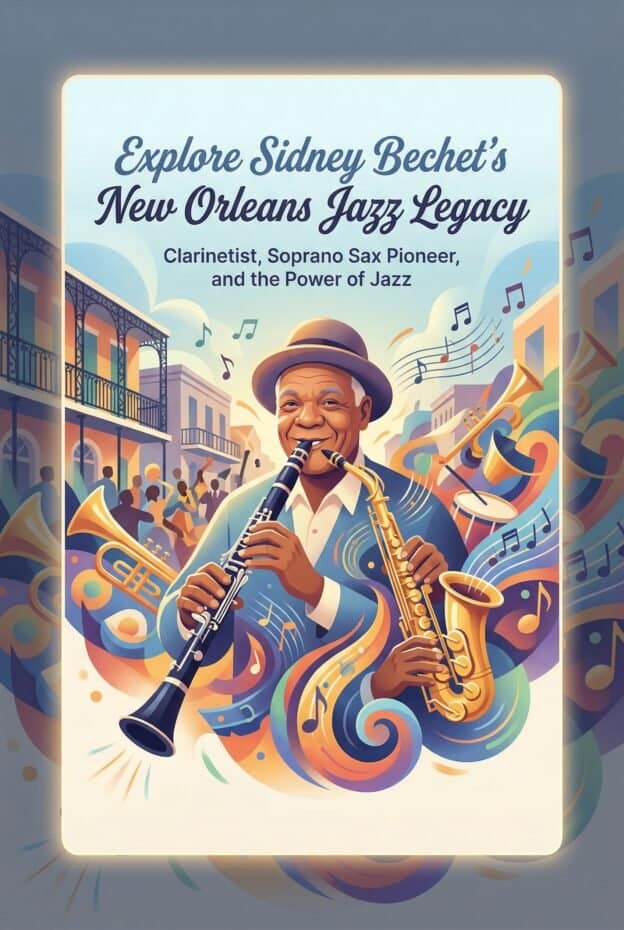Sidney Bechet (born May 14, 1897, New Orleans) was a pioneering jazz clarinetist and soprano saxophonist known for a wide, fast vibrato, vocal-like phrasing, and expressive New Orleans style. His career milestones include his 1923 recordings in Chicago, 1920s Paris prominence, and the 1950s composition of “Petite Fleur.” He died in Paris in 1959.
Who was Sidney Bechet? – Brief biography and historical context
Sidney Bechet was born on May 14, 1897, in New Orleans, Louisiana, into a Creole family where music filled daily life. He began clarinet around age six, learning largely by ear. Early exposure to brass bands, parade music, and dance halls shaped his sound. New Orleans legends such as Lorenzo Tio Jr. and George Baquet influenced his concept of tone and phrasing.
By his teens, Bechet was already a sought-after clarinetist in New Orleans. He played with Bunk Johnson, Freddie Keppard, and other early jazz figures. His style combined blues inflection, operatic vibrato, and a bold, declamatory approach. This mix set him apart from many peers, who favored a drier, more blended ensemble role.
In 1917, Bechet left New Orleans to tour with Will Marion Cook and other traveling ensembles. These tours took him to Chicago, New York, and eventually Europe. The move mirrored a wider migration of New Orleans musicians who carried the emerging jazz style to northern cities and across the Atlantic, changing the soundscape of popular music.
Bechet's first recordings in 1923, including sides with Clarence Williams and Louis Armstrong, captured his clarinet and early soprano saxophone work. These records document a musician already fully formed in tone and rhythmic drive. His switch to soprano sax as a primary instrument would soon define his public image, though clarinet remained central to his musical thinking.
In the 1920s, Bechet became a major figure in Paris, performing with the Revue Nègre and collaborating with artists such as Josephine Baker. His sound thrilled European audiences who had never heard such intensity and freedom. This period also deepened his connection to the French jazz scene, which later embraced him as a foundational figure.
After legal troubles and deportations, Bechet moved between the United States and Europe during the 1930s and 1940s. By the late 1940s, he settled permanently in France, where he found steady work and widespread admiration. In the 1950s, he composed “Petite Fleur,” which became a global hit and cemented his status as a jazz icon.
Bechet died in Paris on May 14, 1959, his 62nd birthday. Today, historians place him alongside Louis Armstrong as one of the first great soloists in jazz. His influence extends from New Orleans clarinet traditions to modern soprano saxophone practice, shaping players from Johnny Hodges to John Coltrane.
Timeline & Key Recordings (1897-1959): dates, moves, and archival sessions
Bechet's life can be understood through a clear timeline of moves and recordings. For serious students, anchoring his style to specific dates and sessions helps track its evolution. This section highlights key periods and recommended listening for clarinetists and soprano saxophonists.
1897-1916: New Orleans childhood and early work
Born May 14, 1897, Bechet learned clarinet by age six and performed in neighborhood bands by his early teens. While no recordings exist from this period, his New Orleans environment, including brass bands and Creole clarinet traditions, shaped his phrasing and vibrato concept.
1917-1922: Touring years, Chicago and New York
Bechet toured with Will Marion Cook's Southern Syncopated Orchestra and other groups, playing clarinet in vaudeville and dance settings. He moved through Chicago and New York, absorbing influences from King Oliver, Jelly Roll Morton, and early big-city jazz scenes.
1923: First recordings in New York and Chicago
Bechet's first known recordings date from 1923. Important tracks include sessions with Clarence Williams' Blue Five and early sides with Louis Armstrong. Listen for his clarinet agility, early soprano sax experiments, and already prominent vibrato.
1924-1929: Paris prominence and European tours
Bechet joined the Revue Nègre in 1925 and toured Europe. In Paris and London, he recorded with British and French bands. Key listening includes his work with Noble Sissle and various French studio groups, where his soprano sax tone becomes more dominant and assertive.
1930s: Return to the United States, swing era context
After legal issues in Europe, Bechet returned to the United States. He recorded in New York with various small groups, often revisiting New Orleans repertoire. These sessions show him adapting his style to swing-era rhythm sections while keeping his intense vibrato and melodic approach.
1940s: Revival and transition to France
The New Orleans revival brought renewed attention to Bechet. He recorded with Bunk Johnson and other traditional jazz bands. By the late 1940s, he moved back to France, where he found stable work, radio appearances, and enthusiastic audiences.
1950s: “Petite Fleur” and late style
In the 1950s, Bechet recorded prolifically in France. He composed “Petite Fleur” around 1952-1953, and it became a hit, especially through later recordings by Chris Barber and Monty Sunshine. Late recordings highlight a slightly slower, more vocal phrasing but retain his signature vibrato.
Recommended listening by decade
1920s: Clarence Williams' Blue Five (1923), “Wild Cat Blues” and “Kansas City Man Blues”.
1930s: New York small group sessions, including “Summertime” and blues features.
1940s: New Orleans revival recordings with Bunk Johnson and related bands.
1950s: French sessions featuring “Petite Fleur,” “Les Oignons,” and live broadcasts.
For archival research, the Library of Congress and the New Orleans Jazz Museum hold important materials, including early photographs, manuscripts, and broadcast recordings. European archives in Paris and London preserve radio sessions and concert tapes that reveal Bechet's interaction with French rhythm sections.
The Bechet Sound: Tone, Vibrato, and Phrasing – measurable characteristics
Bechet's sound is often described as huge, vocal, and almost operatic. To study it seriously, players should think in measurable terms: vibrato speed, width, dynamic range, and phrase length. This approach helps translate a legendary style into concrete practice goals on clarinet or soprano saxophone.
Vibrato speed and width
On classic recordings, Bechet's vibrato often sits around 6 to 8 oscillations per second, which is faster than many modern classical players. The pitch variation can approach a semitone at its widest on sustained notes. This combination creates a dramatic, singing quality that cuts through ensembles.
Air and core tone
Bechet uses a very focused air stream with strong support from the diaphragm and lower abdominal muscles. The tone has a dense core, with a bright edge but not a thin, shrill quality. On soprano sax, this means a centered sound that can project over brass, while on clarinet it produces a penetrating chalumeau and clarion register.
Articulation and attack
His attacks are often slightly accented, with a clear front to the note. He uses a mix of legato tongue, light accents, and occasional growl or smear effects. On blues phrases, he sometimes softens the attack, letting the pitch slide into place with a combination of embouchure and finger motion.
Phrasing and line shape
Bechet's phrasing is strongly vocal. He often builds phrases in 4 or 8 bar units, but within those structures he uses sighing gestures, upward cries, and blues bends. He favors clear melodic outlines over dense bebop lines, yet his rhythmic placement is extremely flexible and conversational.
Rhythmic feel
He tends to play slightly ahead of the beat on climactic notes, which adds urgency. On ballads, he may sit back on the beat, stretching time like a singer. In ensemble passages, he weaves around the beat, creating tension with the rhythm section while still locking into the groove.
Dynamic range
Bechet uses wide dynamics, from soft, almost whispered entrances to powerful, fortissimo peaks. On recordings like “Summertime,” he begins phrases quietly and swells into long, intense notes. This dynamic shaping is as important as vibrato in creating his emotional impact.
For students, measuring vibrato speed with a metronome and recording dynamic changes across phrases can make Bechet's sound more approachable. Aim first for control at slower vibrato rates, then gradually increase speed while maintaining pitch center and tone quality.
New Orleans Clarinet Style: Technique & Exercises (breath, long tones, glissando)
New Orleans clarinet style, as heard in Bechet's early work, blends strong breath support, flexible embouchure, and expressive glissandos. Clarinetists who want to approach this sound must work on long tones, interval flexibility, and controlled slides between notes, especially in the clarion register.
Breath support and long tones
Start with long tones across the chalumeau and clarion registers. Use a full, supported air column, aiming for a dense, ringing sound. Hold each note for 12 to 16 counts at a slow tempo, adding a gentle vibrato only after the core tone is stable and centered.
Exercise: New Orleans long tone ladder
Play a scale in quarter notes at 60 bpm, holding each note for 4 beats, then 8 beats. Focus on smooth register transitions, especially from throat tones to clarion A, B, and C. Record yourself and listen for evenness of tone and consistent pitch across the range.
Glissando basics on clarinet
Clarinet glissandos in Bechet's style rely on a combination of finger motion and embouchure relaxation. On an upward gliss, gradually uncover fingers while slightly loosening the embouchure to let the pitch slide. On a downward gliss, reverse the process, tightening embouchure as fingers close.
Exercise: Two-note glissando drill
Choose a minor third, such as G to B on clarinet. At 50 bpm, play G, then slide to B over one full beat. Use slow finger motion and controlled embouchure change. Repeat descending. Increase the interval to a perfect fourth and then a fifth as control improves.
Clarinet key groups for glissando
Most clarinet glissandos use the left-hand upper stack (A, G, F keys) and right-hand upper stack (E, D, C) in gradual motion. Throat tones and the register key can be adjusted to smooth transitions. Avoid sudden finger lifts; think of a continuous, rolling motion across the key groups.
New Orleans style ornaments
Bechet-style clarinet playing uses grace notes, turns, and short scoops into target notes. Practice adding a quick lower neighbor grace note before sustained tones, especially on chord tones. Keep the grace note light and fast so it feels like a vocal scoop rather than a separate note.
Exercise: 4-bar phrase ornament study
Take a simple 4-bar melody, such as a blues phrase in C. At 70 bpm, play it straight, then add one ornament per bar: a grace note scoop, a short gliss, a turn, and a vibrato swell. Compare the two versions to hear how embellishments bring the line closer to Bechet's expressive language.
Soprano Sax Approach: Bechet's Fingerings, Vibrato, and Phrasing Tips
On soprano saxophone, Bechet created a sound that was both penetrating and lyrical. His approach combined a firm embouchure, fast vibrato, and selective use of alternative fingerings for color. Soprano players studying his style should focus on stability in the upper register and control of vibrato speed.
Embouchure and air on soprano
Use a slightly firmer embouchure than on alto or tenor, with the lower lip cushioning the reed but not collapsing. Direct a fast, focused air stream through the center of the mouthpiece. This helps avoid thin or sharp tone, especially in the palm key range where Bechet often soared.
Vibrato development on soprano
Start with a slower vibrato, around 4 oscillations per second, using jaw motion rather than throat wobble. Once stable, gradually increase to 6 or 7 oscillations per second. Listen to Bechet's sustained notes and match the speed and width, ensuring the pitch center remains clear.
Alternative fingerings for color
Bechet and other early soprano players sometimes used alternative fingerings to darken or brighten specific notes. For example, on written G and A above the staff, experimenting with side key combinations can slightly alter timbre. Use a tuner to keep pitch stable while exploring these color options.
Exercise: Color tone study on soprano
Choose a mid-register note, such as written D or E. At 60 bpm, sustain for 8 beats using standard fingering, then 8 beats with an alternative fingering that slightly changes color. Record and compare. Aim for subtle timbral shifts without major pitch deviation.
Phrasing and breath control
Bechet's soprano lines often span long, arching phrases. Practice 8-bar phrases at a slow tempo, taking only one breath. Focus on shaping each phrase with a dynamic swell and a clear emotional contour. Think of each line as a sung sentence with a beginning, middle, and end.
Exercise: Bechet-style phrase contour
Take a simple melody, such as “When the Saints Go Marching In.” At 60 bpm, play 8-bar segments, starting mezzo-piano, swelling to forte by bar 5, then tapering back to mezzo-piano. Add vibrato only on the last 2 beats of long notes at first, then expand as control improves.
Upper register stability
Bechet often pushed into the upper soprano range with intensity. To avoid sharpness, practice long tones on palm key notes with a tuner. Keep the jaw relaxed and the air steady. If pitch rises, slightly lower the tongue position and open the throat while maintaining air speed.
Practice Routines & Workshop Notes: step-by-step drills with metronome settings
Turning Bechet's style into daily practice requires structured routines. The following step-by-step drills are designed for clarinet and soprano sax players who want measurable progress in vibrato, phrasing, and glissando. Use a metronome and a recording device for every session.
HowTo: Bechet Vibrato Control Routine
This routine builds from slow, controlled vibrato to Bechet-like speed. Plan for 15 to 20 minutes per day, 4 to 5 days per week.
- Step 1: Straight tone baseline
Tool: Metronome at 60 bpm. Duration: 3 minutes.
Play long tones on G, A, B (clarinet or soprano) for 8 beats each with no vibrato. Focus on stable pitch and full tone. - Step 2: Slow vibrato at 4 oscillations per second
Tool: Metronome at 60 bpm. Duration: 5 minutes.
On each note, pulse the pitch slightly down and back up 4 times per second. Count “1-e-&-a” per beat, matching each subdivision to a vibrato cycle. - Step 3: Medium vibrato at 6 oscillations per second
Tool: Metronome at 60 bpm. Duration: 5 minutes.
Increase vibrato speed to 6 oscillations per second. Use a lighter jaw motion and stronger air support. If pitch wobbles too far, reduce width slightly. - Step 4: Bechet-range vibrato at 7-8 oscillations per second
Tool: Metronome at 60 bpm. Duration: 5 minutes.
Aim for 7 to 8 oscillations per second on sustained notes. Keep the sound centered. Record and compare to Bechet recordings, adjusting width to taste.
HowTo: New Orleans Glissando Builder
This drill focuses on smooth clarinet glissandos similar to Bechet's expressive slides.
- Step 1: Half-step slides
Tool: Metronome at 50 bpm. Duration: 4 minutes.
On clarinet, slide from F to F-sharp and back over one beat. Use gradual finger motion and slight embouchure adjustment. - Step 2: Whole-step gliss
Tool: Metronome at 50 bpm. Duration: 4 minutes.
Slide from E to F-sharp and back, taking a full beat for each slide. Focus on even motion and avoiding sudden jumps. - Step 3: Third and fourth intervals
Tool: Metronome at 60 bpm. Duration: 6 minutes.
Practice glissandos over minor thirds and perfect fourths, such as G to B-flat, then G to C. Use two beats for each slide. - Step 4: Phrase-level glissandos
Tool: Metronome at 70 bpm. Duration: 6 minutes.
Insert one glissando into a 4-bar blues phrase, always leading into a strong beat. Record and adjust timing so the slide feels natural and vocal.
HowTo: Bechet Phrasing & Breath Routine
This routine trains long, vocal phrases with dynamic shaping.
- Step 1: 4-bar breath control
Tool: Metronome at 60 bpm. Duration: 5 minutes.
Play 4-bar phrases on a simple tune, taking one breath per phrase. Shape each phrase with a gentle swell in the middle. - Step 2: 8-bar phrases
Tool: Metronome at 56 bpm. Duration: 7 minutes.
Extend to 8-bar phrases, still using one breath. Focus on relaxed throat and consistent air speed. - Step 3: Add vibrato at phrase peaks
Tool: Metronome at 60 bpm. Duration: 8 minutes.
On the highest or most emotional note in each phrase, add Bechet-style vibrato at 6 to 7 oscillations per second, then taper back to straight tone.
Instrument Setup & Anatomy: mouthpiece, reed, and alternative fingering notes
Equipment cannot replace practice, but it can support a Bechet-like sound. Understanding mouthpiece, reed, and key group behavior helps clarinet and soprano sax players shape tone, vibrato, and glissandos more effectively. Small setup adjustments often solve persistent tone and tuning issues.
Mouthpiece tip opening and facing
Bechet-era mouthpieces often had moderate tip openings compared with some modern jazz designs. A medium tip opening with a balanced facing curve can provide enough resistance for strong air support without encouraging biting. This helps maintain a dense core tone suitable for wide vibrato.
Reed strength and response
For a Bechet-like sound, many players prefer a reed that is strong enough to support loud dynamics but not so hard that it chokes soft attacks. A medium to medium-hard strength often works well. Rotate reeds regularly and break them in over several days to maintain consistent response.
Clarinet anatomy and key groups
On clarinet, the upper stack keys (left-hand index, middle, ring) and right-hand upper stack are central to smooth glissandos and note bends. Throat tones interact with the register key and side keys to shape timbre. Understanding how each key affects resistance helps control slides and color changes.
Soprano sax key groups
On soprano, the palm keys and side keys greatly influence upper register tone. Slight changes in side key combinations can darken or brighten notes like high D, E, and F. Practice long tones with different key combinations, using a tuner, to map which options provide stable pitch and desired color.
Alternative fingerings for color
Both clarinet and soprano sax offer alternative fingerings that subtly change tone. For example, on clarinet, some players vent certain notes with side keys to brighten the sound. On soprano, alternative fingerings for high G or A can soften brightness. Always check pitch and keep a log of useful options.
Maintenance for consistent response
Regularly check pads, tenons, and corks for leaks, which can sabotage vibrato and glissando control. Clean the mouthpiece daily with warm water and a soft brush. Store reeds in a ventilated case and allow them to dry between uses to prevent warping and mold.
Humidity and reed behavior
Reeds respond to humidity changes. In dry environments, they may feel harder and respond sluggishly; in very humid conditions, they can feel soft and unstable. Keep a small humidity-controlled container in your case and test reeds before important practice sessions focused on Bechet-style vibrato.
Legacy, Notable Recordings and Archives to Study (including “Petite Fleur”)
Sidney Bechet's legacy reaches across clarinet, soprano sax, and jazz history. He helped define the role of the soloist in early jazz, influenced generations of European musicians, and left a recorded legacy that remains important study material for improvisers and educators.
Influence on clarinet and saxophone players
Bechet's sound inspired clarinetists such as Barney Bigard and Albert Nicholas, and saxophonists including Johnny Hodges and later John Coltrane, who also explored soprano saxophone. His intense vibrato and vocal phrasing set a model for expressive solo playing that contrasted with more restrained ensemble styles.
Key recordings to study
Early 1920s: “Wild Cat Blues” and “Kansas City Man Blues” with Clarence Williams' Blue Five for clarinet agility and early soprano sound.
1930s: “Summertime” and blues features for ballad phrasing and dynamic control.
1940s: New Orleans revival sides with Bunk Johnson for ensemble interplay and traditional repertoire.
“Petite Fleur” and 1950s sessions
“Petite Fleur,” composed in the early 1950s, showcases Bechet's lyrical side. Study both his own recordings and later versions by European bands. Focus on the melodic simplicity, the shape of the main theme, and how vibrato and dynamics carry the emotional weight of the tune.
Archives and research resources
The Library of Congress holds important early jazz recordings and documents that contextualize Bechet's American career. The New Orleans Jazz Museum preserves artifacts related to the city's early jazz scene, including materials connected to Bechet's contemporaries. European radio archives in Paris and London contain live broadcasts that reveal his interaction with local rhythm sections.
Bechet in jazz history
Historians often place Bechet alongside Louis Armstrong as one of the first great jazz soloists. While Armstrong defined trumpet and vocal phrasing, Bechet did similar work for clarinet and soprano sax. His confrontational, passionate style challenged later generations to balance technical control with emotional intensity.
Study path for modern players
A practical listening path might start with the 1923 Clarence Williams sides, move to 1920s Paris recordings, then to 1930s ballads like “Summertime,” and finally to 1950s French sessions featuring “Petite Fleur” and “Les Oignons.” Transcribing short phrases from each decade helps trace how his style matured while core elements remained.
Key Takeaways
- Sidney Bechet was a pioneering New Orleans clarinetist and soprano saxophonist whose fast, wide vibrato and vocal phrasing helped define early jazz solo style.
- His sound can be approached through measurable practice: vibrato speed, long tones, glissando drills, and phrase-length breath control on clarinet and soprano sax.
- Equipment choices, especially mouthpiece and reed balance, support but do not replace strong air support, flexible embouchure, and careful listening to key recordings from 1923 to the 1950s.
FAQ
What is Sidney Bechet?
Sidney Bechet was a New Orleans-born jazz clarinetist and soprano saxophonist, born May 14, 1897. He became one of the first great jazz soloists, known for a powerful tone, fast vibrato, and expressive phrasing that influenced clarinet and saxophone players worldwide.
How did Sidney Bechet develop his distinctive vibrato?
Bechet's vibrato grew from New Orleans clarinet traditions, vocal influences, and strong air support. He used a fast jaw vibrato, often 6 to 8 oscillations per second, combined with a dense core tone. Years of performing in loud dance halls pushed him to project, which reinforced his wide, dramatic vibrato style.
Which recordings and dates are best to study Bechet's style?
Start with his 1923 recordings with Clarence Williams' Blue Five, then his 1920s Paris sessions. Add 1930s tracks like “Summertime” for ballad phrasing, 1940s New Orleans revival sides for ensemble context, and 1950s French sessions featuring “Petite Fleur” and “Les Oignons” for his mature soprano sound.
How can a clarinetist practice Bechet-style phrasing and glissandos?
Clarinetists should work on long tones with strong breath support, then add slow, controlled vibrato. For glissandos, practice sliding between small intervals with gradual finger motion and slight embouchure relaxation. Insert short glissandos into simple 4-bar blues phrases, always leading into strong beats to keep the line musical.
What mouthpiece/reed setup helps approximate Bechet's tone?
A medium tip opening mouthpiece with a balanced facing and a medium to medium-hard reed often supports a Bechet-like tone. This combination allows strong air support and wide vibrato without losing control. Regular reed rotation, careful break-in, and daily mouthpiece cleaning help maintain consistent response for expressive playing.







